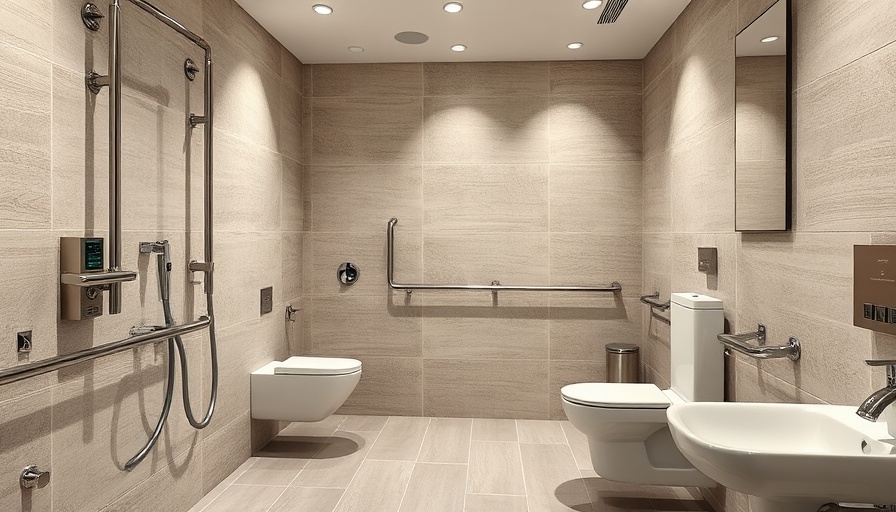
Understanding the Vital Role of Accessible Bathrooms
For many caregivers supporting individuals with mobility challenges, the necessity of a wheelchair-accessible bathroom transcends mere convenience; it is fundamentally tied to enhancing quality of life. In Ocean County and beyond, caregivers play a crucial role in creating and maintaining such spaces, which are essential for enabling independence and dignity. Accessible bathrooms not only promote self-sufficiency but also ensure individuals feel respected and empowered.
Designing an Inclusive Environment: Key Considerations
Creating an accessible bathroom requires thoughtful planning and execution. Effective design begins with three core elements: adequate space, logical layout, and suitable fixtures. According to best practices, a minimum of 60 inches of turning space is essential for wheelchair users, allowing them the freedom to maneuver without obstacle. Caregivers should prioritize wide doorways and clear paths to minimize risks and enhance comfort.
Additionally, deciding where to place fixtures—such as toilets, sinks, and shower units—can significantly impact the safety and usability of the bathroom. Leveraging adjustable or wall-mounted fixtures accommodates a variety of user heights, improving accessibility. Making these strategic choices not only fulfills regulatory standards but also transcends basic functionality, fostering an environment where users can thrive.
Choosing Effective Fixtures for Safety and Comfort
The selection of bathroom fixtures is pivotal for establishing a practical space. Accessible sinks should be set no higher than 34 inches from the floor and feature knee clearance to support wheelchair users effectively. Consider installing user-friendly faucets, such as single-lever or touchless designs, which can greatly enhance ease of use, especially for those with limited dexterity.
Toilets also merit special attention; a raised toilet seat paired with strategically placed grab bars offers critical support during transfers. It's essential to select grab bars that can handle substantial weight and are securely anchored in wall studs to prevent accidents.
Showering Comfort: The Role of Roll-in Showers
A roll-in shower is an optimal solution for many caregivers aiming to improve bathtub accessibility. Unlike traditional showers, roll-in designs facilitate easy access for wheelchair users and often include features such as showerheads mounted at adjustable heights for greater flexibility. Adding anti-slip mats and ensuring grab bars are installed near the shower entry can further enhance safety for all users.
Current Trends in Bathroom Accessibility
As the aging population grows, the demand for accessible bathrooms continues to rise. According to experts, there is increasing recognition of universal design, a concept that advocates for creating spaces usable by everyone, regardless of age or ability. Caregivers can leverage this insight when discussing bathroom modifications with clients, helping them understand how inclusive designs can improve everyday experiences.
Several trends indicate a shift toward more personalized approaches in creating accessible spaces. For example, many individuals prefer incorporating technology in their bathrooms, such as smart shower systems or automatic lighting controls, which enhance both accessibility and independence. A well-designed space thus becomes not only safer but also a pleasure to use.
The Emotional Impact of Accessibility
Accessibility considerations extend beyond the physical aspects. For many caregivers, witnessing their loved ones regain control over their daily routines brings immense emotional satisfaction. Having a fully accessible bathroom can significantly alter someone's quality of life, providing them with the confidence to take care of personal hygiene without assistance. This empowerment can lead to improved mental health and overall well-being.
Conclusion: Taking Steps Towards an Accessible Future
As they journey on their caregiving paths, individuals in Ocean County must prioritize the creation of accessible bathrooms. By investing time and resources in making necessary modifications, caregivers support both the physical safety and emotional well-being of those they care for. The insights shared in this article highlight the critical elements needed to foster dignity and independence.
To help spread awareness about the importance of accessible bathroom solutions for mobility-challenged individuals, we encourage caregivers to share their experiences and advocate for inclusivity in home environments.
 Add Row
Add Row  Add
Add 




Write A Comment